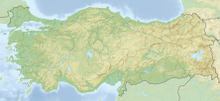Troy
![]()
The title of this article is ambiguous. For other meanings of Troy or Troia, see Troy (disambiguation).
Troy (Ancient Greek Τροία Troia or Τροίη Troiē; also ἡ Ἴλιος hē Ílios, "the Ilios" or τὸ Ἴλιον tó Ílion, "the Ilion"; Latin Troia or Ilium; Turkish Truva) was a city in ancient times. According to modern doctrine, it was located in the landscape of Troas in northwestern modern Turkey. In ancient studies, the Latin spelling Troia is used, which corresponds to the ancient Greek spelling.
The historicity and localization of Troy is controversial (see Troy debate). A widespread research opinion locates Troy on Hisarlık Tepe in the province of Çanakkale (Turkey). The site is a UNESCO World Heritage Site.
Geography
39.9572222226.2386111111Coordinates: 39° 57′ 26″ N, 26° 14′ 19″ E
|
Troy |
|
Turkey |
Troy was very probably located on the 15-meter-high settlement mound Hisarlık (Turkish for "castle mound") at the Dardanelles. It is possible that the settlement controlled access to the Black Sea since the Bronze Age. Ships could not cross against the wind at that time. According to Manfred Korfmann, they therefore waited in the harbour of the fortress for favourable winds, and the tolls and pilotage and protection fees which the ships had to pay to Troy brought wealth to the city. This view is, however, controversial: both the existence of substantial shipping from the Mediterranean to the Black Sea during the Late Bronze Age and the fact that the port of the fortress would have been used for this purpose are doubted.
The place gained fame in antiquity through the poem Iliad by Homer and the legendary Trojan War described there. Even in late antiquity, the place and its legendary heroes were highly revered in the Roman Empire (see Aeneid), and the hill Ilium was widely known. With the onset of the Christian Middle Ages, Troy (and with it the location of the city) fell into oblivion.
The existence and location of Troy have been among the most controversial topics in archaeology for two centuries. The divergent opinions eventually led to the Troy debate. Today, the majority of ancient scholars believe that a settlement layer on the Hisarlık is the Troy described by Homer. In Homer, the site is primarily called Ilios (Greek Ἴλιος) and at one point Ilion (Ἴλιον). It remains unclear to what extent Homer's description of a war is accurate.
Aftermath
Based on the name of the former Colonia Ulpia Traiana, the terms Troia Minor ("Little Troy") and Troia Francorum ("Frankish Troy") were also established for Xanten until the Middle Ages. Around 1100, the Annolied finally told of the founding of Xanten by the defeated Trojans in the Trojan War:
| Middle High German | Translation (Eberhard Nellmann, Reclam edition) | |
| 389 390 391 392 393 394 395 396 | Franko gesaz with the sînin vili verre nidir bî Rîni. dâ worhtin si duo with vroudin a luzzele Troii. the brook hîzin si Sante nâ demi wazzere in iri lante; den Rîn havitin si vure diz meri. dannin wuohsin sint Vreinkischiu heri. | Franko let himself be taken with his own far away on the Rhine. There they built at that time with joy a little Troy. They called the brook Sante after the river of their homeland. They took the Rhine instead of the sea. There the Frankish people grew since then. |
As early as 1444, when Xanten fell to the Duchy of Cleves, coins were minted with the inscription Joannes Troianorum Rex ("John, King of the Trojans").
Questions and Answers
Q: Where was Troy located?
A: Troy was located in north-west Asia Minor, in what is now Çanakkale province in northwest Turkey.
Q: What is the significance of Troy?
A: Troy was the center of the Trojan War, which was depicted in eight epic poems, including the Iliad and the Odyssey.
Q: What is the current status of Troy?
A: Today, Troy is an archaeological site located in Hisarlik in Anatolia, close to the seacoast.
Q: Who wrote the Iliad and the Odyssey?
A: The Iliad and the Odyssey were written by Homer.
Q: How many epic poems depict the Trojan War?
A: The Trojan War was depicted in eight epic poems, six of which were from the Epic Cycle.
Q: What is the significance of the Dardanelles in relation to Troy?
A: The Dardanelles are located southwest of Troy, near the seacoast in what is now Çanakkale province in northwest Turkey.
Q: Has Troy been recognized for its historical significance?
A: Yes, UNESCO has listed the archaeological site of Troy as a World Heritage Site.
Search within the encyclopedia
